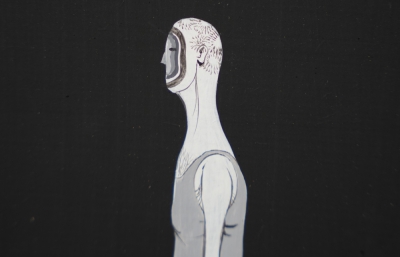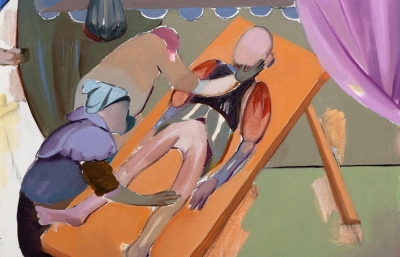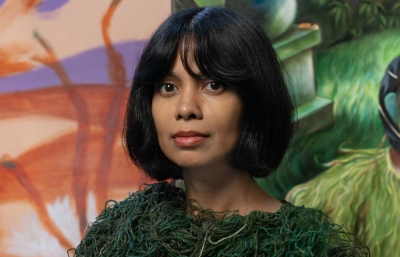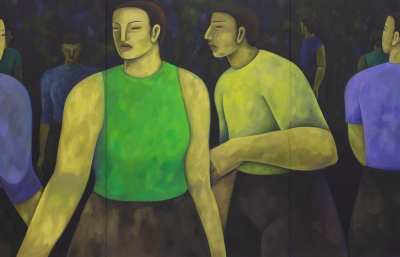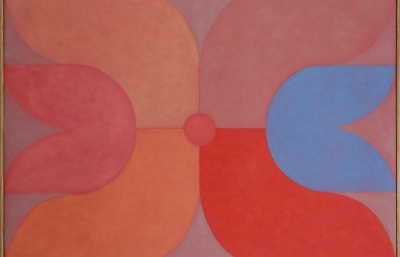Hilda Palafox
The Open Vessel
Interview by Gwynned Vitello // Portrait by Karla Ximena Cerón
Hilda Palafox is known for glorious, colorful murals and confident, comfortable paintings of women, but an appreciation of her ceramics gives extra insight into an artist who exquisitely portrays the fragile and the sturdy. In making vessels that can stand alone or hold something special, she continues work as a carrier of the material, as well as the intangible. She herself is like a vessel, channeling new ideas, people and places, portraying the humble and the mighty, expressing life’s dualities in work that is approachable, but full of depth. I spoke with the Mexico City-based artist who just showed her newest series, Un día a la vez, at Thinkspace Projects
Gwynned Vitello: In a previous interview, you remember a tarot reading where the moon card came up frequently. I don’t know anything about tarot cards, but that seems so fitting. For me, it recalls phases of the moon, and your images portray so many moods in what look like simple round shapes. Were you surprised at what the cards revealed?
Hilda Palafox: I don't know anything about tarot cards either, but at that moment, I was about to start working on my first solo show in the U.S. and I still didn’t have a theme or even a slight idea of what I wanted to do. I thought that maybe the reading a friend did for me after breakfast one morning in L.A. would reveal something, something mystical. Well... it didn't, ha ha. But it was a good reading, a positive one, and I remember getting a good vibe from it. The moon was a symbol that I couldn’t stop thinking about after the reading, and it ended up being a very important storyteller in the show and a constant element in my work.
The round shapes in my work do not always reference the moon, but you’re right, they can represent a whole variety of moods. I like to flirt with abstraction from time to time, in a world where these geometrical shapes could mean a lot of things, like a feeling or a memory; sometimes it’s just another earthly object that I felt no need to represent in another way.

I was disappointed to learn that there’s no scientific data showing a relationship between women’s cycles and the phases of the moon, but I still like the idea. Diana the Huntress was Goddess of the Moon, right? Have you always had a fascination with the physical and spiritual aspects of womanhood?
I think so, yes. Since I can remember, as a girl, I always felt very attracted and curious about the female figure without knowing exactly why. Now, as a woman, I understand it as the main space that I inhabit and the vessel through which I experience the universe. Of course, the similarities we have with the natural world that surrounds us are undeniable; the cycles, the seasons, the phases of the moon. I have always had a fascination with contemporary women who break through the glass ceiling. The rule breakers, making changes and paving the way, they are also part of my inspiration. I try to translate all of this into my work in a poetic kind of way.
I have one sister and grew up in a home where my father worked long hours with a lot of overnights. My classic Italian Nonni was a dominant figure, so I feel like I grew up in a female “flavored” home? How about you, and how did that influence your sense of confidence and life goals?
I have two sisters. My father was always very present even though he worked long hours as well. But it was definitely a very female-infused home. Both of my parents lost their fathers when they were very young so my grandmothers had to take care of the whole family by themselves. It was hard, since both of them came from small towns and had no education whatsoever. This city can be a complicated place in general, for women even more so, especially back then. They’re very serious and kind of tough ladies, I didn’t like that very much when I was a kid, of course, but it became clear, over the years, why they were like that, and I began to really admire them. So, for me, they are truly an inspiration of character and determination.
Describe your experience in art school and how you felt about starting out in design production. When you took a corporate job, did you think of it as temporary? Tell me about the positive aspects—and then how you decided to make the break.
I loved my art school years. I remember them very fondly. I really enjoyed all the projects, the working sleepless nights and the creativity flowing everywhere. There was so much talent. My world expanded exponentially and I met some of my best friends to date. When I started to work in advertising, I actually thought it was the best thing that could ever happen to me! Ha ha… Everybody said it was the best job, but I realized very quickly that it was not what I expected, that it was not what I wanted to do for the rest of my life. I was just not as passionate and committed as some of my colleagues, you know? I saw them getting very excited about winning a Cannes Lions award and I was like, “hmm... OK, whatever.” I definitely learned a lot and I do not regret it. I am one of those people who think that everything happens for a reason. So I took what I needed from that experience and continued flowing.

You’re a young woman on your own in a big city, embarking on a career as a professional artist. How did it feel and what was your first project?
I think it was kind of scary at the beginning because I had left my comfort zone and I had no idea where to begin. My friend sort of lived off her art, so I think I thought at that moment, why not? I am not sure, it’s kinda cloudy exactly how I made the decision to quit my job. I guess I just took a leap of faith without thinking about it too much. Otherwise, I would probably still work there! At first, my idea was to freelance, doing graphic design with some art and illustration thrown in for good measure. I think my first project was probably something editorial.
In the mural world, the first wall I ever painted was on the second floor of a rooftop at a building located in La Doctores, a well-known neighborhood here in Mexico City. I had no background working in graffiti or street art, but already knew some people in that world, so I didn’t wait for an invitation! I just went for it. The first festival I was invited to paint at was in 2015 in Holbox, the Mexican Caribbean. As far as studio work, my first show outside of Mexico was in 2016, at a group show with Cass Contemporary in Tampa, Florida.
How did you get the artist residency in Japan? What was most memorable and how did you secure a solo show there? What was the theme of your first show?
It was one of those once-in-a-lifetime opportunities. One day, I received an email from this Colombian guy who lives in Japan saying he had seen my work in a magazine and wanted to invite me to take an artist residency there, with the idea of showing the work of different Latin American artists in Japan. He had already invited a Colombian artist the previous year and I would be the second. He also took care of getting the space, which was the gallery of the Cervantes Institute in Tokyo.
The whole experience was incredible and I remember it very fondly. I learned a lot about myself, and this ended up being the theme for the exhibition, the experience itself. I found myself living in a very different culture, so I tried to portray the way I was feeling during that time. The exhibition marked the closure of that adventure. I still feel very grateful.
I pick up such an upbeat, enthusiastic vibe from you, so it seems natural that you like working with other people. Was your first mural a group effort? Tell me about it.
Thank you! Yes, I love collaborating with friends and colleagues whenever I have the opportunity. My friends are pretty talented. I had help from one with the first mural I painted because the wall was on kind of a dangerous second floor and I needed someone to hold the ladder for me while I was painting. In the end, he also helped me paint and we had a really nice time. We laughed, played music and made friends with all the neighbors and local street food vendors.

Do you ever get to choose a mural site, or is it always assigned? Do you have favorite locations, any particular memories from the different cities? What do the various locations have to offer?
I don't remember ever choosing a wall other than picking one from a preselected list. Too bad. But every location has its own magic. I think the most amazing part is always being able to connect and learn from different cultures. One of my favorite experiences was when I painted in Brazil at the Além da Rua Festival, curated by Instagrafite on that special occasion. I painted a wall by the beach in Fortaleza, and in another part of the project we traveled to Pecém, a small fishing village nearby. We were 13 artists, almost all from Latin America, and each one of us painted a sail for the fishing boat of local fishermen.
All the locals welcomed us warmly and were very grateful for our visit. It’s a small town where not much happens usually, you know? That was a great event for them and it was an incredible experience for all of us.
Mexico City offers such wonderful art, food and public spaces. What are your personal reasons for living there, and what does it offer compared to other cities—or for that matter, living in the country?
I have never visualized myself living anywhere else. I do not compare Mexico City with any other place, not that it is better or worse; it’s just that I really love it here. It’s a big city with such a cool, young, sometimes crazy, creative energy, where something is always happening. My dream is to live in the countryside in a city near Mexico City so I can visit friends and family and get that chaotic vibe from time to time. I don’t know when that will happen, but I hope soon.

Here I go again with the round shapes. When did you start making ceramics, and tell me about your favorite forms in this medium. Do you make them while you’re working on paintings and murals?
When I first got into ceramics, I had more free time on my hands, so I used to take lessons and went to the pottery studio once or twice a week. I think it was around 2014, and it was more of a hobby, I guess. As you probably know, ceramics require a lot of work and patience. Now, like you said, I have to split my time and sometimes one piece of pottery can take up to a month of work, so I don't do it as much as I’d wish. I really like traditional pre-Columbian ceramics and sculptures so, from there I take a lot of inspiration. Hence, a lot of round shapes!
What’s your process, and how does a painting come about? Maybe you take photos, but I imagine your sketchbook is always handy and closeby.
I never take photos of anything, maybe just of my own hands any time I can't get the shape or position right. Also, I look at a couple of references when I include another living creature, like an animal or something I don’t know exactly how to do. But, honestly, everything comes out of my head and goes directly into the sketchbook. I don't care much about proper shapes, perspectives or anatomically correct bodies. It is more about what the body language expresses and how the whole piece can make you feel. Sometimes I do quick digital color exercises, but I always change those directly during the painting process.
I guess this is kind of chicken and egg, but how does your inspiration end up on a wall or canvas? Do you sometimes listen to music, the news, or a conversation that sparks an idea, or a storage house of thoughts saved up? Is there a vision of groups of paintings or sometimes, a unique, individual piece of work?
I have a ton of ideas for new pieces stored in my head, but I am not always in the mood for any of those, so I leave them for when I feel blocked or whatever. Almost all of my work comes from current situations or feelings, readings or conversations, like you mentioned. Although sometimes they are only a couple of pieces, I usually like to work on different visualizations of a single idea if possible.

It could be colors that provide inspiration. How has your use of color evolved over the years in terms of paint choice and application method? I’m super interested in how you choose the colors—mood, location, personal journey?
Sometimes I just want to paint random color compositions because they make me feel at peace, you know? At the beginning, I worked a lot in black and white, then started slowly introducing color, so it would be bIack, white and one or two bright colors. And then when I moved from paper to canvas, I began to paint fully colored pieces. At first I painted with acrylics but I recently started to experiment with oils because I felt the need to get more information out of one color. It was very difficult for me to achieve that with acrylics. Colors and I, we have a very complicated relationship. You see, my use of color is very visceral, instinctual and almost automatic, not at all studied. I let it flow freely and it depends a lot on how I am feeling in that particular moment and as you can imagine, some days are better than others.
You seem to luxuriate in rich, deep color. Do you love it so much that the interior of your house is in color? Is your wardrobe basic black?
Even though I love color, I have a very sober home so far. It has some hints of color here and there but I have yet to venture out into colored walls. I do not reject that idea though—maybe someday. As far as my wardrobe goes, I used to dress only in black for a long time but now I am subtly letting color back in.
Colors may be my current crush but black and white is forever! I will never tire of it, so I always try to come back, as a break from the world of color.

When we briefly talked about your portrait, you immediately got enthusiastic about gathering with your girlfriends to come up with a concept. We touched on it a bit earlier, but how do your friends contribute to what you do? I’m sure many of them are artisans, but I bet a lot of them have other things they offer.
I have the good fortune of being surrounded by a lot of talented people doing different things in different areas. I do not have a lot of portraits of myself, so when you asked me about capturing one, I immediately thought about getting in touch with Ximena to do it. She is so talented and I love the vision she has. I was really excited to work with her again. Like I mentioned before, it is always nice to get together or create an excuse to collaborate with friends.
Are you constantly thinking about what is next, or are you satisfied with your current painting and ceramics?
All the time. I am never completely satisfied with what I do. And that is the thing, right? The engine that keeps us creating, I suppose, to help us not get bored with ourselves.
And, of course, I have to ask how you got the nickname PONI?
It is such a boring story, actually. I never thought I would have to tell it so many times! When I was still working in advertising, I opened my blogspot to share some of the illustrations I did in my free time to keep me mentally sane. I wanted to name it “ponytail“ but that name was already taken so I changed the spelling to “ponitail”. After that, some of my friends started to call me Poni, and that was it. I thought it was a cool, fun, short name to sign my work. Now I sign my paintings as Hilda Palafox and leave PONI for the mural stuff.


